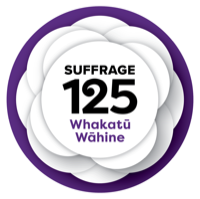Suffrage Day is a special day in New Zealand’s history. Thursday 19 September 2019 is Suffrage Day / White Camellia Day.
Why is Suffrage Day celebrated?
On the 19th of September 1893, New Zealand became the first nation in the world to grant women the right to vote. This year marks the 126 anniversary of women winning the right to vote in New Zealand. The white camellia was the symbol of the suffragists.
What is Suffrage Day?
Suffrage Day provides an opportunity for people to celebrate New Zealand’s suffrage achievements and look for ways to benefit women.
How do we commemorate this day?
- Wearing a white camellia. Why? These flowers were worn by people supporting women’s right to vote in New Zealand.
- Wear a The Suffrage 125 symbol. Why? The symbol draws on historical colours and icons adopted by women’s suffrage petitioners and presents them in a contemporary form.
Where can I find information about the suffragettes and and Suffrage Day?
- ManyAnswers has a page dedicated to websites, resources and ways to search for information about the suffragettes and Suffrage Day.
- NZ History has some amazing pages dedicated to women’s suffrage day and Suffrage 125.
- See who signed the 1893 Women’s Suffrage Petition
- See images on Digital NZ of Cartooning the women’s vote.
- Also check out these amazing books!
Amazing women: 101 lives to inspire you.
Read this story of 101 extraordinary women of our time. Empowering and inspiring accounts of female pioneers include the likes of JK Rowling, Rosalind Franklin, Beyonce Knowles, Marie Curie, Malala Yousafzai, Angela Merkel and Serena Williams. A beautiful package that rejoices in the remarkable and crucial contributions women have made to our society. Women’s suffrage.
Women’s suffrage.
“Find out interesting, little-known facts such as how the suffragists were the first people to ever picket the White House and how the nineteenth amendment granting women the right to vote passed by only one vote when a legislator changed his vote to “yes” after receiving a letter from his mother telling him to “do the right thing.” The unique details, along with the clever interior illustrations, make this series stand out from the competition”– Provided by publisher.
“When Kate Sheppard was a young lady jauntily exploring the streets of her new home in Christchurch, the world was a different place. Women did not ride bicycles or participate in outdoor activities like sports. And they certainly were not allowed to vote. But Kate wanted to do more, and she knew that women deserved the same opportunities as their male counterparts. Her campaign would become the battle of a lifetime. Includes an end section of facts about women’s rights around the world”–Publisher information.
 Eliza and the white camellia : a storyof suffrage in New Zealand.
Eliza and the white camellia : a storyof suffrage in New Zealand.
New Zealand suffragist Eliza Wallis was a first-wave feminist who actively sought the Vote for Women. She was a founding member of the National Council of Women in 1896. Her story is told by her fourth great niece in this bilingual children’s picture book, a Suffrage 125 project.
A beautifully illustrated celebration of the brave campaigners who fought for women’s right to vote. Tracing its history from New Zealand at the end of the 19th century, follow this empowering movement as it spread from Oceania to Europe and the Americas, then Africa and Asia up to the present day. Meet the women who rioted, rallied and refused to give up.
 Suffragettes and the fight for the vote.
Suffragettes and the fight for the vote.
“This book takes up the story in the mid 19th century, when the first petition was presented to Parliament, and traces the fight for the vote through the work of suffrage organisations and the suffragettes. From peaceful demonstrations to violent campaigns and prison hunger strikes, the story is brought to life through fascinating historical photos and artefacts”–Back cover.
 Be counted! : the diary of Amy Phelps, Dunedin, 1893.
Be counted! : the diary of Amy Phelps, Dunedin, 1893.
Thirteen year old Amy goes to live with her aunt and uncle in Dunedin to continue her education. At Otago Girls’ High she pursues her dream of becoming an artist like her hero, Frances Hodgkins. Meanwhile, all Aunt Delia can talk about is the campaign to get women the vote. But Amy soon finds some girls who need more urgent help. Her efforts to find her wayward friend Mary lead her to discover a dark side lurking behind Dunedin’s stately buildings. Includes historical photographs. Suggested level: intermediate, junior secondary.


